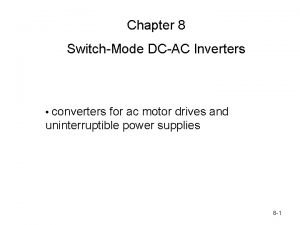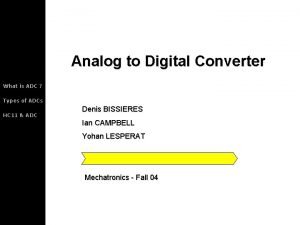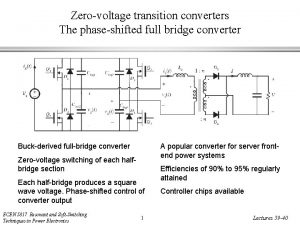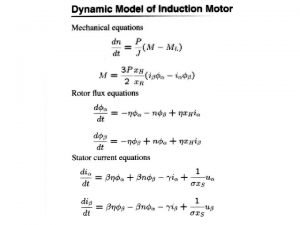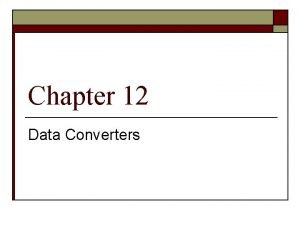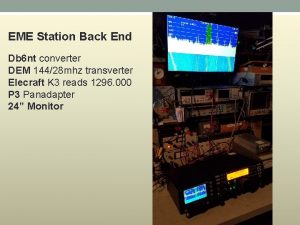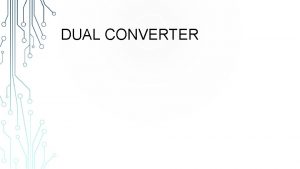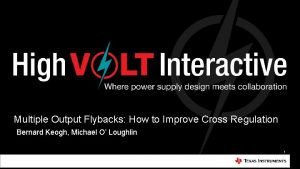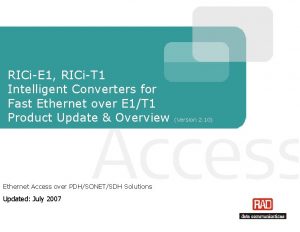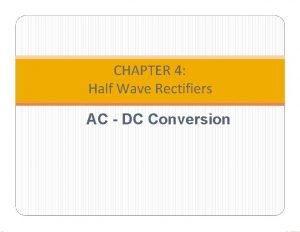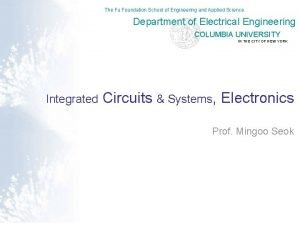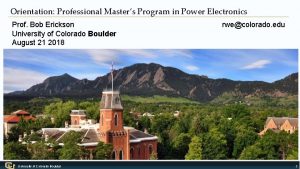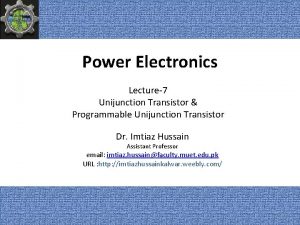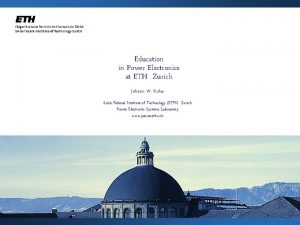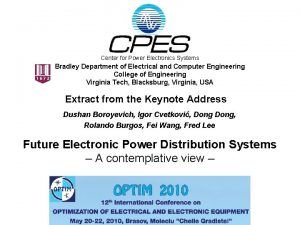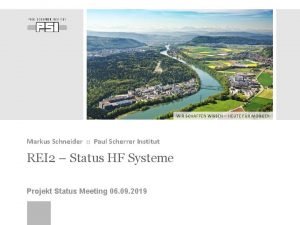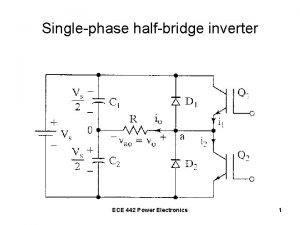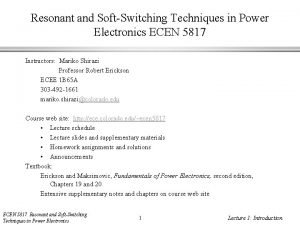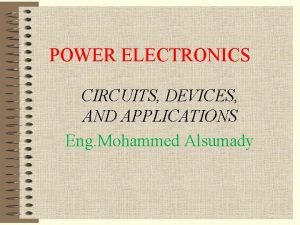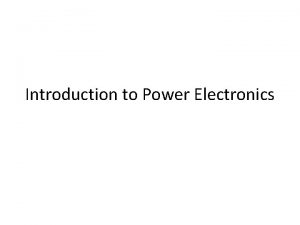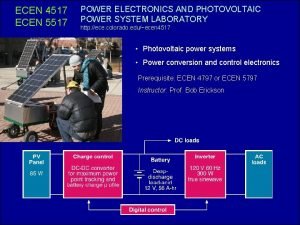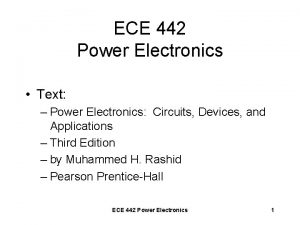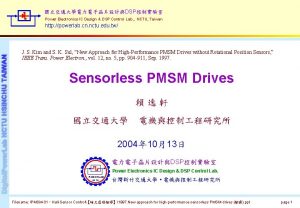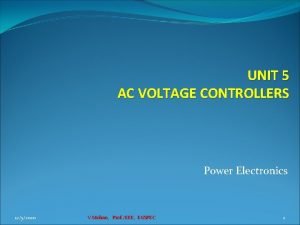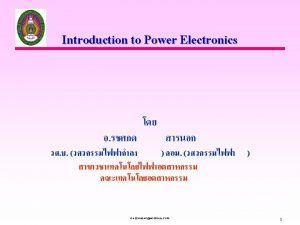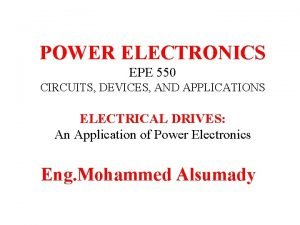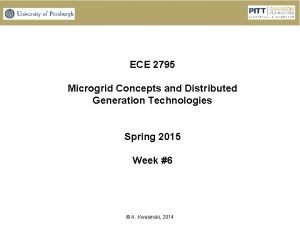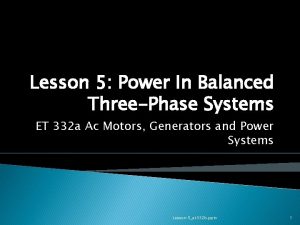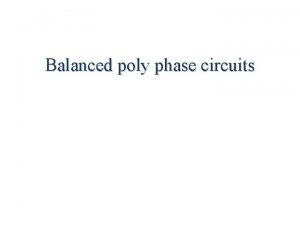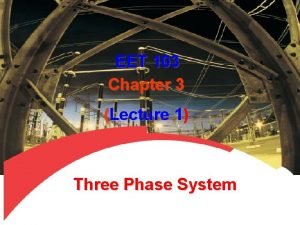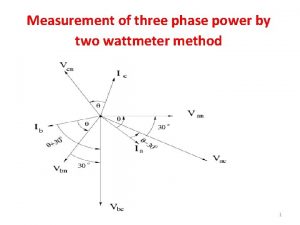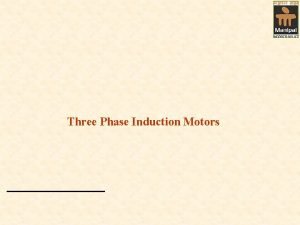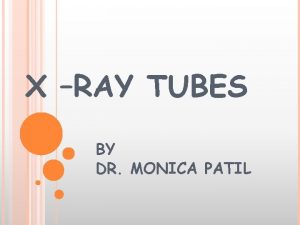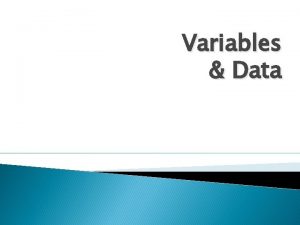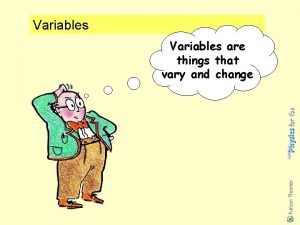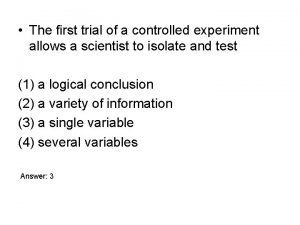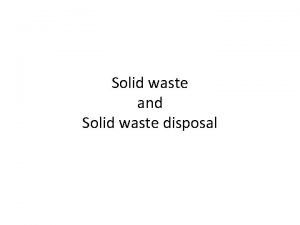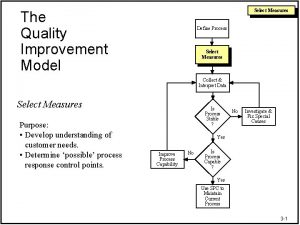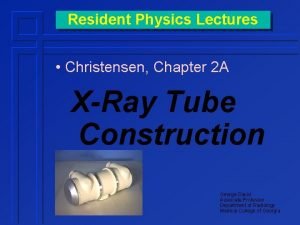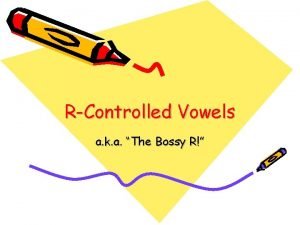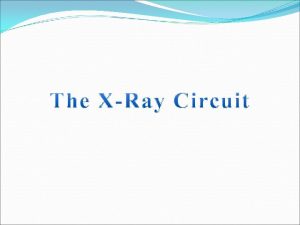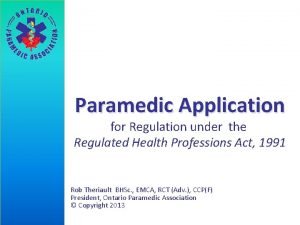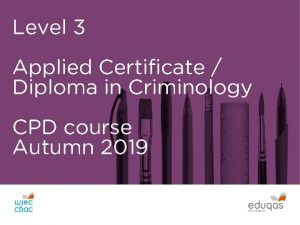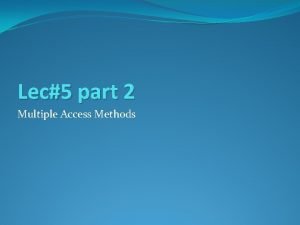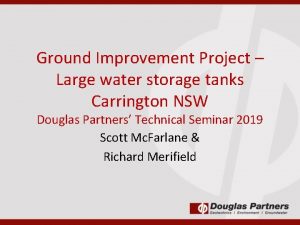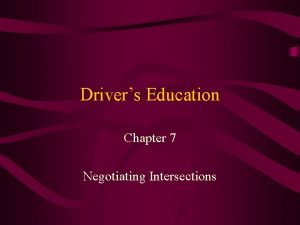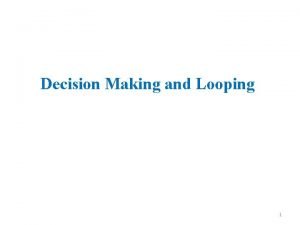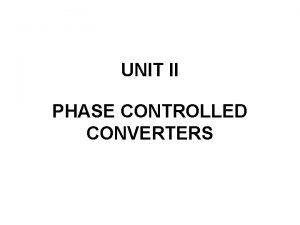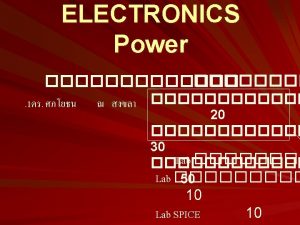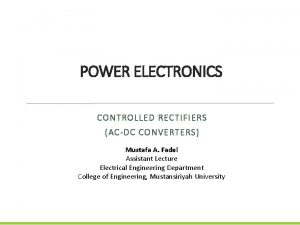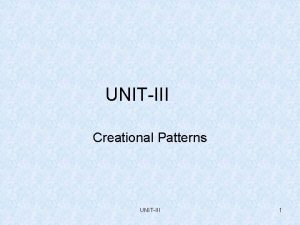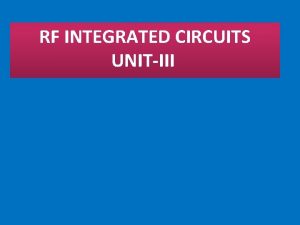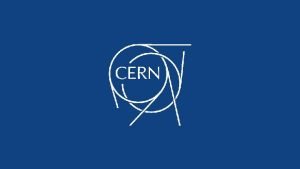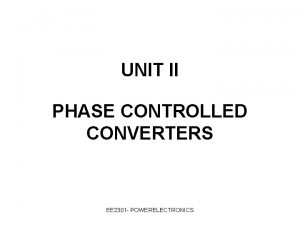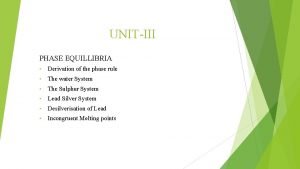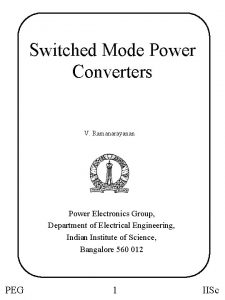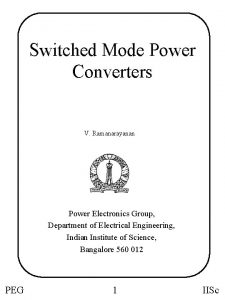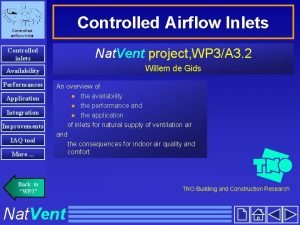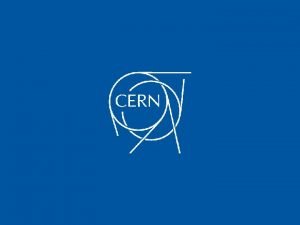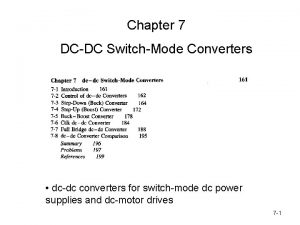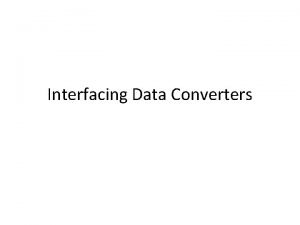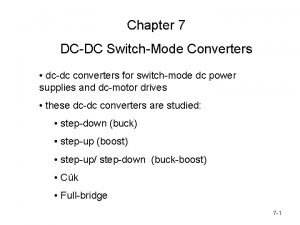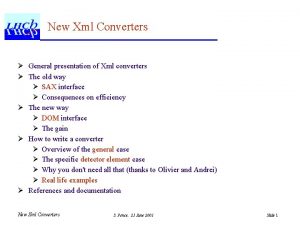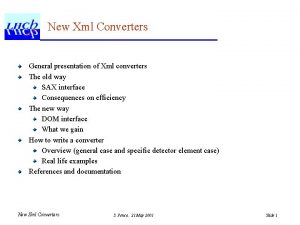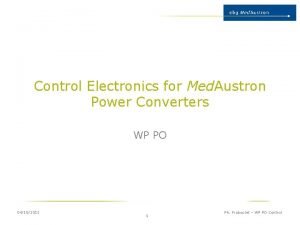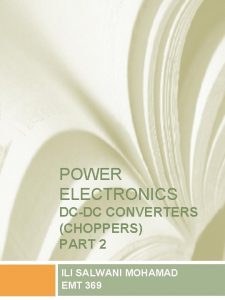POWER ELECTRONICS UNITIII PHASE CONTROLLED CONVERTERS Prof V













































































- Slides: 77

POWER ELECTRONICS UNIT-III PHASE CONTROLLED CONVERTERS Prof. V. N. Bhonge Dept. of Electronics & Telecomm Shri Sant Gajanan Maharaj College of Engg, Shegaon – 444203 vnbhonge@rediffmail. com

SSGMCE Shegaon Unit II PHASE CONTROLLED CONVERTERS Principle of phase control, half wave controlled rectifier, half controlled bridge & fully controlled bridge rectifier for resistive and RL load, derivation for output voltage and current, effect of free wheeling diode, single phase dual converters. Three phase half controlled bridge and fully controlled bridge rectifier. Prof. V. N. Bhonge Dept. of E & TC

Phase-Control Converters Single-Phase Three-Phase Semiconverter Full converter Dual converter Prof. V. N. Bhonge Dept. of E & TC

Semiconverter. . is a one-quadrant converter and it has one polarity Full converter. . is a two-quadrant converter and the polarity of its output can be either positive or negative. However the output current of full converter has one polarity only Dual converter. . can operate in four quadrants ; both the output voltage and current can be either positive or negative Prof. V. N. Bhonge Dept. of E & TC

CONTROLLED RECTIFIER Phase controlled rectifier circuits Prof. V. N. Bhonge Dept. of E & TC

Prof. V. N. Bhonge Dept. of E & TC

Prof. V. N. Bhonge Dept. of E & TC

SINGLE-PHASE HALF-WAVE CONVERTER WITH R LOAD 8 Prof. V. N. Bhonge Dept. of E & TC

SINGLE-QUADRANT OPERATION Prof. V. N. Bhonge Dept. of E & TC

WAVEFORMS: Prof. V. N. Bhonge 10 Dept. of E & TC

Average Output Voltage Maximum Output Voltage Normalizing Output Voltage RMS Output Voltage

Average Dc voltage & RMS across resistance load Prof. V. N. Bhonge Dept. of E & TC

Example: If the converter has a purely resistive load of R and the delay angle is , determine )a) the rectification efficiency )b) the form factor FF )c) the ripple factor RF and (d) the peak inverse voltage PIV of thyristor T 1 Prof. V. N. Bhonge Dept. of E & TC

Solution: )a) the rectification efficiency Prof. V. N. Bhonge Dept. of E & TC

)b) the form factor FF )c) the ripple factor RF )d) the peak inverse voltage PIV of thyristor T 1 Prof. V. N. Bhonge Dept. of E & TC

EXAMPLE Design a circuit to produce an average voltage of 40 V across 100 load resistor from a 120 Vrms 60 Hz ac source. Determine the power absorbed by the resistor and the power factor. Briefly describe what happen if the circuit is replaced by diode to produce the same average output. Prof. V. N. Bhonge Dept. of E & TC

EXAMPLE (CONT)… Solution In such that to achieved 40 V average voltage, the delay angle must be • If an uncontrolled diode is used, the average voltage would be • That means, some reducing average resistor to the design must be made. A series resistor or inductor could be added to an uncontrolled rectifier, rectifier while controlled rectifier has advantage of not altering the load or introducing the losses

CONTROLLED, HALF-WAVE CONVERTER WITH R-L LOAD Prof. V. N. Bhonge Dept. of E & TC

Con…. • The analysis of the circuit is very much similar to that of uncontrolled rectifier. Prof. V. N. Bhonge Dept. of E & TC

CONT…. Prof. V. N. Bhonge Dept. of E & TC

Controlled full-wave rectifiers with R Load Prof. V. N. Bhonge Dept. of E & TC

The power delivered to the load The rms current in source is the same as the rms current in the load. Prof. V. N. Bhonge Dept. of E & TC

Single-Phase Full Converter with RL Load Rectification Mode Inversion Mode Prof. V. N. Bhonge Dept. of E & TC

OPERATION : vs is positive is is positive power flows from vs to the load vs is negative is is positive power flows from load to vs Prof. V. N. Bhonge 24 Dept. of E & TC

2 -QUADRANT OPERATION Prof. V. N. Bhonge Dept. of E & TC

Cont… Prof. V. N. Bhonge Dept. of E & TC

Single-Phase Full Converter (RL-load( Mode 1 = Mode 2 Prof. V. N. Bhonge Dept. of E & TC

Single-Phase Full Converter (RL-load( RMS Current for Thyristor RMS Output Current AVG Output Current Prof. V. N. Bhonge Dept. of E & TC

Controlled Single-phase converter operating as an inverter:. • Average value of vd is negative for 90 o< <180 o. Average power Pd is negative (Pd=Vd. Id) and thus power flows from the dc to the ac side • On the ac side, Pac=Vs. Is 1 cosf 1 is also negative because f 1>90 o • Inverter mode of operation is possible because there is a source of energy on the dc side • ac side voltage source provides commutation of current from one pair of thyristors to the others Prof. V. N. Bhonge Dept. of E & TC

For inverter operation, power is supplied by the dc source, and power is absorbed by the bridge and is transferred to the ac system. Vdc and Vo must be negative For …………rectifier operation ………inverter operation Prof. V. N. Bhonge Dept. of E & TC

Half Controlled Bridge (Semiconverter) a) Symmetrical b) Asymmetrical Prof. V. N. Bhonge Dept. of E & TC

Average and RMS Value of output voltage Prof. V. N. Bhonge Dept. of E & TC

Single-Phase Semiconverter (RL-load( Mode 1 Mode 2 Prof. V. N. Bhonge Dept. of E & TC

Single-Phase Semiconverter (RL-load( RMS Current for Thyristor RMS Output Current AVG Output Current

Problem : The single-phase semiconverter has an RL load of L = 6. 5 m. H, R = 2. 5 Ohm, and E = 10 V. The input voltage is VS = 120 V(rms) at 60 Hz. Determine )a) the load current IL 0 at , and the load current IL 1 at, )b) the average thyristor current IA )c) the rms thyristor current IR )d) the rms output current Irms and (e) the average output current Idc Prof. V. N. Bhonge Dept. of E & TC

3 PHASE CONTROLLED RECTIFIERS Operate from 3 phase ac supply voltage. They provide higher dc output voltage. Higher dc output power. Higher output voltage ripple frequency. Filtering requirements are simplified for smoothing out load voltage and load current. Prof. V. N. Bhonge Dept. of E & TC

Extensively used in high power variable speed industrial dc drives. Three single phase half-wave converters can be connected together to form a three phase half-wave converter. Prof. V. N. Bhonge Dept. of E & TC

VECTOR DIAGRAM OF 3 PHASE SUPPLY VOLTAGES Prof. V. N. Bhonge Dept. of E & TC

Prof. V. N. Bhonge Dept. of E & TC

THREE-PHASE FULL CONVERTER 40 Prof. V. N. Bhonge ECE 442 Pow er Elect roni Dept. of Ecs & TC

WAVEFORMS: Prof. V. N. Bhonge Dept. of E & TC

The line-to-neutral voltages are: Then the line-to-line voltages are: Prof. V. N. Bhonge Dept. of E & TC

The average output voltage is found from: The rms value of the output voltage is: Prof. V. N. Bhonge Dept. of E & TC

A three-phase bridge gives a six-pulse output voltage. For high -power applications such as high-voltage dc transmission, a 12 pulse output is generally required to reduce the output ripples and to increase the ripple frequencies. Two six-pulse bridges can be combined either in series or in parallel to produce a 12 -pulse output. Prof. V. N. Bhonge Dept. of E & TC

3 PHASE HALF CONTROLLED BRIDGE CONVERTER (SEMI CONVERTER) WITH HIGHLY INDUCTIVE LOAD & CONTINUOUS RIPPLE FREE LOAD CURRENT Prof. V. N. Bhonge Dept. of E & TC

Prof. V. N. Bhonge Dept. of E & TC

WAVE FORMS OF 3 PHASE SEMICONVERTER FOR > 600 Prof. V. N. Bhonge Dept. of E & TC

Prof. V. N. Bhonge Dept. of E & TC

Prof. V. N. Bhonge Dept. of E & TC

WAVE FORMS OF 3 PHASE SEMICONVERTER FOR 600 Prof. V. N. Bhonge Dept. of E & TC

Prof. V. N. Bhonge Dept. of E & TC

Prof. V. N. Bhonge Dept. of E & TC

Prof. V. N. Bhonge Dept. of E & TC

EXPRESSION FOR THE AVERAGE OUTPUT VOLTAGE OF 3 PHASE SEMICONVERTER FOR > / 3 AND DISCONTINUOUS OUTPUT VOLTAGE Prof. V. N. Bhonge Dept. of E & TC

Prof. V. N. Bhonge Dept. of E & TC

Prof. V. N. Bhonge Dept. of E & TC

Prof. V. N. Bhonge Dept. of E & TC

SINGLE-PHASE DUAL CONVERTER In previous section, we have seen that the single-phase full converters with inductive loads allow only two-quadrant operation. If two of these converters are connected back to back, both the output voltage and the output current can be reversed. This system will provide four-quadrant operation and it is called a dual converter. Prof. V. N. Bhonge Dept. of E & TC

Dual converters are used in high-power variable-speed drives. If α 1 and α 2 are the delay angles of converters 1 and 2, the corresponding average output voltages will be Vdc 1 and Vdc 2. Prof. V. N. Bhonge Dept. of E & TC

Circuit Diagram and Waveforms: Prof. V. N. Bhonge Dept. of E & TC

The delay angles are controlled such that one converter operates as a rectifier and the other converter operates as an inverter. However, both converters produce the same average output voltage. Therefore, Prof. V. N. Bhonge Dept. of E & TC

One converter is rectifying and the other one is inverting, therefore: Since the instantaneous output voltages of the two converters are out of phase, there will be an instantaneous voltage difference between the two converters. Prof. V. N. Bhonge Dept. of E & TC

This will result in a circulating current between the two converters. The dual converters can be operated with or without a circulating current. In case of operation without the circulating current, only one converter operates at a time and carries the load current. The other converter is completely blocked by inhibiting gate pulses. Prof. V. N. Bhonge Dept. of E & TC

There are two different modes of operation. § Circulating current free (non circulating) mode of operation § Circulating current mode of operation Prof. V. N. Bhonge Dept. of E & TC

Non Circulating Current Mode Of Operation In this mode of operation only one converter is switched on at a time When the converter 1 is switched on, For 1 < 900 the converter 1 operates in the Rectification mode Vdc is positive, Idc is positive and hence the average load power Pdc is positive. Power flows from ac source to the load Prof. V. N. Bhonge Dept. of E & TC

When the converter 1 is on, For 1 > 900 the converter 1 operates in the Inversion mode Vdc is negative, Idc is positive and the average load power Pdc is negative. Power flows from load circuit to ac source. Prof. V. N. Bhonge Dept. of E & TC

When the converter 2 is switched on, For 2 < 900 the converter 2 operates in the Rectification mode Vdc is negative, Idc is negative and the average load power Pdc is positive. The output load voltage & load current reverse when converter 2 is on. Power flows from ac source to the load Prof. V. N. Bhonge Dept. of E & TC

When the converter 2 is switched on, For 2 > 900 the converter 2 operates in the Inversion mode Vdc is positive, Idc is negative and the average load power Pdc is negative. Power flows from load to the ac source. Energy is supplied from the load circuit to the ac supply. Prof. V. N. Bhonge Dept. of E & TC

CIRCULATING CURRENT MODE OF OPERATION Both the converters are switched on at the same time. One converter operates in the rectification mode while the other operates in the inversion mode. Trigger angles 1 & 2 are adjusted such that ( 1 + 2) = 1800 Prof. V. N. Bhonge Dept. of E & TC

When 1 < 900, converter 1 operates as a controlled rectifier. 2 is made greater than 900 and converter 2 operates as an Inverter. Vdc is positive & Idc is positive and Pdc is positive. Prof. V. N. Bhonge Dept. of E & TC

Three Phase Dual Converters For four quadrant operation in many industrial variable speed dc drives , 3 phase dual converters are used. Used for applications up to 2 mega watt output power level. Dual converter consists of two 3 phase full converters which are connected in parallel & in opposite directions across a common load. Prof. V. N. Bhonge Dept. of E & TC

Circuit Diagram: Prof. V. N. Bhonge Dept. of E & TC

Waveforms: Prof. V. N. Bhonge Dept. of E & TC

Outputs of Converters 1 & 2 the interval ( /6 + 1) to ( /2 + 1), the line to line voltage vab appears across the output of converter 1 and vbc appears across the output of converter 2 During Prof. V. N. Bhonge Dept. of E & TC

Four Quadrant Operation Prof. V. N. Bhonge Dept. of E & TC

ADVANTAGES OF THYRISTOR CONVERTERS Thyristor converters provides controlled transfer of power between the line frequency ac and adjustable-magnitude dc By controlling , transition from rectifier to inverter mode of operation can be made and vice versa Thyristor converters are mostly used at high-power levels Thyristor converters inject large harmonics into the utility system Prof. V. N. Bhonge Dept. of E & TC

SSGMCE Shegaon Thank You Prof. V. N. Bhonge Dept. of E & T
 Dcac converters
Dcac converters Types of adc
Types of adc Catalytic converter reaction
Catalytic converter reaction Flyback converter
Flyback converter Dcac converters
Dcac converters Digital to analog converters basic concepts
Digital to analog converters basic concepts Eme converters
Eme converters Single phase dual converter
Single phase dual converter Cross regulation definition
Cross regulation definition Intelligent converters
Intelligent converters Single phase controlled rectifier with rl load
Single phase controlled rectifier with rl load Triangle of power
Triangle of power Fu foundation school of engineering and applied science
Fu foundation school of engineering and applied science Ecen 5797
Ecen 5797 What is programmable unijunction transistor
What is programmable unijunction transistor Johann w. kolar
Johann w. kolar Center for power electronics systems
Center for power electronics systems Ampegon power electronics ag
Ampegon power electronics ag Ece 442
Ece 442 Power electronics
Power electronics Power electronics circuits devices and applications
Power electronics circuits devices and applications Introduction to power electronics
Introduction to power electronics Power transfer system
Power transfer system Power electronics
Power electronics Dsp in power electronics
Dsp in power electronics Ac voltage controller and cycloconverter
Ac voltage controller and cycloconverter Power electronics
Power electronics Power electronics
Power electronics Rectifier power electronics
Rectifier power electronics Normal phase vs reverse phase chromatography
Normal phase vs reverse phase chromatography Hplc reverse phase vs normal phase
Hplc reverse phase vs normal phase Mobile phase and stationary phase
Mobile phase and stationary phase Mobile phase in chromatography
Mobile phase in chromatography Normal phase vs reverse phase chromatography
Normal phase vs reverse phase chromatography Power formula three phase
Power formula three phase Detectors used in hplc
Detectors used in hplc In a triangle connected source feeding a y connected load
In a triangle connected source feeding a y connected load Broad phase vs narrow phase
Broad phase vs narrow phase Ac systems lesson 5
Ac systems lesson 5 Four phase power
Four phase power In a y-connected source feeding a ∆-connected load,
In a y-connected source feeding a ∆-connected load, Three-phase power
Three-phase power Power stages in induction motor
Power stages in induction motor Solar power satellites and microwave power transmission
Solar power satellites and microwave power transmission Actual power
Actual power Flex28024a
Flex28024a Dispersive power of a grating is
Dispersive power of a grating is Power of a power property
Power of a power property General power rule
General power rule Power angle curve in power system stability
Power angle curve in power system stability Power bi training powerpoint
Power bi training powerpoint Power absorbed or supplied
Power absorbed or supplied Grid controlled x ray tube
Grid controlled x ray tube In 1914 who controlled the shaded areas on the map
In 1914 who controlled the shaded areas on the map Controlled variable examples
Controlled variable examples What is a control variable
What is a control variable Controlled substance log example
Controlled substance log example Roman empire theme
Roman empire theme The first trial of a controlled experiment allows
The first trial of a controlled experiment allows Controlled and uncontrolled observation example
Controlled and uncontrolled observation example Controlled access zone vs warning line
Controlled access zone vs warning line Controlled tipping method
Controlled tipping method Felix biestek 7 principles
Felix biestek 7 principles Examples of controlled variables
Examples of controlled variables Grid controlled x ray tube
Grid controlled x ray tube List of er words
List of er words Falling load generator x ray
Falling load generator x ray Controlled acts
Controlled acts What is the control variable in an experiment
What is the control variable in an experiment Ac1.2 criminology unit 3
Ac1.2 criminology unit 3 Controlled access methods
Controlled access methods Computer controlled telescopes
Computer controlled telescopes Controlled modulus column
Controlled modulus column Geometrical symbol
Geometrical symbol Control variables examples
Control variables examples Drug basket method is used for
Drug basket method is used for What is an uncontrolled railroad crossing
What is an uncontrolled railroad crossing Exit controlled loop flowchart
Exit controlled loop flowchart
